School Donation Letter
Subject: Request for Donation to [School Name]
Dear [Recipient's Name],
I hope this letter finds you in good health and high spirits. I am writing to you today on behalf of [School Name] to request your generous support in the form of a donation. We believe in the transformative power of education, and with your assistance, we can continue providing exceptional learning opportunities to our students.
At [School Name], we strive to create an environment that fosters academic excellence, personal growth, and community engagement. Our dedicated faculty and staff are committed to nurturing the intellectual, social, and emotional development of our students, empowering them to become confident and responsible individuals.
As you may be aware, maintaining and improving the quality of education requires continuous effort and financial resources. Unfortunately, our school is currently facing budgetary constraints that limit our ability to provide the best educational experience for our students. This is why we are reaching out to our community for support.
Your generous donation would enable us to enhance our academic programs, invest in innovative teaching methods, provide necessary learning resources, and upgrade our facilities. Additionally, it would contribute to our scholarship fund, allowing deserving students to access a quality education regardless of their financial circumstances.
We are flexible in accepting donations of any amount, and we appreciate every contribution, big or small. In recognition of your generosity, we would be delighted to acknowledge your donation prominently on our school website and at our annual events. Furthermore, [School Name] is a registered non-profit organization, and your donation may be tax-deductible as permitted by law.
Enclosed with this letter, you will find a donation form that outlines the various ways you can contribute to [School Name]. Whether you prefer a one-time donation or an ongoing partnership, we welcome your support. Please feel free to contact me directly at [Phone Number] or [Email Address] if you have any questions or if you would like to discuss the various opportunities for involvement.
Together, we can make a lasting impact on the lives of our students and shape a brighter future for our community. We sincerely hope that you will consider supporting [School Name]'s mission and vision. Your donation will be an investment in the education of our future leaders and will create ripples of positive change for years to come.
Thank you for your time and consideration. We look forward to your favorable response.
With deepest gratitude,
[Your Name]
[Your Title/Position (if applicable)]
[School Name]
General School Donation Request Letter
Subject: Supporting Our Students' Future
Dear [Donor Name],
I hope this letter finds you well. I am writing to you on behalf of [School Name], where we are committed to providing quality education and opportunities for our students.
Our school serves [number] students from diverse backgrounds, many of whom face financial challenges that limit their access to essential educational resources. We are reaching out to community members like you who share our vision of empowering young minds through education.
We are currently seeking donations to support [specific program/need]. Your contribution, regardless of size, will directly impact our students by [explain specific impact]. Last year, generous donations helped us [mention past achievement].
A donation of [suggest amount range] would allow us to [specific outcome]. However, any amount you can contribute will make a meaningful difference in a child's educational journey.
All donations are tax-deductible, and we will provide you with a receipt for your records. You can make your donation by [payment methods] or contact us at [contact information].
Thank you for considering our request. Together, we can create brighter futures for our students.
Warm regards,
[Your Name]
[Your Title]
[School Name]
[Contact Information]
Emergency Fundraising Letter for School Crisis
Subject: Urgent: Help Needed for [School Name]
Dear [Donor Name],
I am writing to you during a critical time for our school community. [Describe emergency: fire damage, natural disaster, unexpected budget cuts, etc.].
This unexpected crisis has left us [describe immediate impact on students and operations]. Our students, who depend on a stable learning environment, are now facing [specific challenges].
We need to raise [amount] within [timeframe] to [specific urgent needs]. Without immediate support, we risk [consequences].
Your emergency donation will help us:
- [Specific urgent need 1]
- [Specific urgent need 2]
- [Specific urgent need 3]
Every dollar counts in this critical moment. We understand this is short notice, but our students cannot wait. Please consider making an immediate contribution at [donation link/method].
We will keep you updated on our progress and how your donation makes a difference during this challenging time.
With gratitude and urgency,
[Your Name]
[Your Title]
[School Name]
[Contact Information]
Corporate Sponsorship Request Letter
Subject: Partnership Opportunity with [School Name]
Dear [Corporate Contact Name],
I am reaching out to explore a mutually beneficial partnership between [Company Name] and [School Name]. As a respected leader in our community, your organization has demonstrated a commitment to [relevant corporate value].
We are seeking corporate sponsors for [specific program/event/initiative] that will serve [number] students in our community. This partnership offers your company valuable visibility while making a tangible impact on education.
Sponsorship benefits include:
- Recognition in all event materials and promotional content
- Logo placement on [specify locations]
- Mention in press releases and social media (reaching [number] followers)
- Speaking opportunity at [event]
- Tax-deductible contribution receipt
We offer several sponsorship levels:
- Platinum Sponsor: [amount] - [benefits]
- Gold Sponsor: [amount] - [benefits]
- Silver Sponsor: [amount] - [benefits]
Your investment will directly support [specific outcomes] and demonstrate [Company Name]'s commitment to education and community development.
I would welcome the opportunity to discuss this partnership in more detail. Please let me know your availability for a brief meeting.
Thank you for considering this opportunity to invest in our students' futures.
Professionally yours,
[Your Name]
[Your Title]
[School Name]
[Contact Information]
Thank You Letter for Previous Donation
Subject: Your Impact on Our Students - Thank You!
Dear [Donor Name],
I wanted to take a moment to express our heartfelt gratitude for your generous donation of [amount] to [School Name]. Your support means the world to our students and staff.
Thanks to your contribution, we were able to [specific accomplishment/purchase/program funded]. I thought you might like to know exactly how your donation made a difference: [provide specific example or story].
[Optional: Include brief student testimonial or achievement enabled by donation]
Your belief in our mission inspires us to continue striving for excellence in education. Donors like you are the reason we can offer opportunities that would otherwise be impossible for many of our students.
We hope you will consider supporting us again in the future. We will keep you informed about upcoming initiatives and the ongoing impact of contributions like yours.
With sincere appreciation,
[Your Name]
[Your Title]
[School Name]
[Contact Information]
P.S. Enclosed is your tax-deductible donation receipt for your records.
Alumni Donation Appeal Letter
Subject: Give Back to the School That Shaped Your Future
Dear [Alumni Name],
As a proud graduate of [School Name], Class of [Year], you experienced firsthand the transformative power of the education we provide. I hope your memories of your time here remain as cherished as ever.
Today, I'm writing to ask you to give back to the institution that helped shape who you are today. Our school continues to face the challenge of providing quality education with limited resources, and we need alumni like you to help us maintain the standards of excellence you remember.
Since you graduated, our school has [mention improvements/changes], but we still need support for [current needs]. We are launching an alumni giving campaign to [specific goal].
Your gift, at any level, will help current students experience the same opportunities you had—or perhaps even better ones. Consider what your education here meant to you and what it enabled you to achieve.
Even a modest donation of [suggested amount] can [specific impact]. Imagine the difference we can make together if every alumnus contributes.
Will you join your fellow alumni in supporting the next generation? Visit [donation link] or mail your contribution to [address].
Let's keep the legacy alive.
With school pride,
[Your Name]
[Your Title]
[School Name]
[Contact Information]
Grant Application Cover Letter to Foundation
Subject: Grant Application for [Project Name]
Dear [Foundation Name] Grant Committee,
I am writing to submit [School Name]'s application for funding under your [specific grant program]. Our proposed project aligns closely with your foundation's mission to [foundation's mission].
[School Name] is a [type] school serving [number] students in [location/demographic description]. We have identified a critical need for [describe need] that prevents our students from [desired outcome].
Our proposed project, [Project Name], will address this need by [brief description]. Over [timeframe], we will serve [number] students and achieve the following measurable outcomes:
- [Outcome 1 with metric]
- [Outcome 2 with metric]
- [Outcome 3 with metric]
We are requesting [amount] to fund this initiative. The attached proposal includes detailed budget information, project timeline, evaluation methods, and our school's qualifications.
Our track record demonstrates our capacity to execute this project successfully. [Mention relevant past achievements or grants].
This project represents a sustainable solution that will continue benefiting students beyond the grant period through [sustainability plan].
Thank you for considering our application. We would be honored to partner with [Foundation Name] to make this vision a reality. Please contact me if you need any additional information.
Respectfully submitted,
[Your Name]
[Your Title]
[School Name]
[Contact Information]
Enclosures: Full grant proposal, budget, supporting documents
Casual Email to Parent Community for Fundraiser
Subject: Help Us Reach Our Goal - Fun Fundraiser This Weekend!
Hi [School Name] Families,
We're so close to our fundraising goal for the new playground equipment, and we need your help to push us over the finish line!
This Saturday, we're hosting our annual [Event Name], and it's going to be a blast. There will be food, games, activities for kids, and a silent auction with some amazing items donated by local businesses.
Here's how you can help:
- Attend the event! Tickets are [price] per family
- Donate an item for the silent auction
- Volunteer for a couple of hours (we still need help with setup and face painting)
- Spread the word to friends and neighbors
Every penny raised goes directly toward the playground project. Can you imagine the joy on our kids' faces when they get to play on brand-new equipment? Let's make it happen together!
RSVP by Wednesday so we know how much food to order. Reply to this email or sign up at [link].
See you Saturday!
[Your Name]
[Your Title/Role]
[School Name]
P.S. Can't make it? You can still donate online at [link]. Every contribution helps!
Memorial Donation Request Letter
Subject: Honoring [Deceased's Name] Through Education
Dear [Recipient Name],
During this difficult time of loss, I wanted to reach out regarding a meaningful way to honor the memory of [Deceased's Name].
[Deceased's Name] had a profound connection to [School Name] as [describe relationship: former student, parent, teacher, volunteer, etc.]. Their impact on our school community will not be forgotten.
We would like to establish [memorial fund/scholarship/program] in [Deceased's Name]'s honor. This tribute will ensure their legacy lives on by [specific impact on students].
If you would like to make a memorial donation, contributions can be sent to [address] or made online at [link]. Please indicate that your donation is in memory of [Deceased's Name].
All donors will be acknowledged in [memorial publication/plaque/ceremony], and the family will be notified of your thoughtful gesture.
Your support during this time helps transform grief into lasting good for students who will benefit from [memorial purpose] for years to come.
With sympathy and gratitude,
[Your Name]
[Your Title]
[School Name]
[Contact Information]
What is a School Donation Letter and Why is it Needed
A school donation letter is a formal or informal written request for financial contributions, goods, or services to support educational institutions and their programs. Schools rely on these letters to bridge funding gaps that standard budgets cannot cover, enabling them to provide enhanced educational experiences, maintain facilities, purchase equipment, fund special programs, and offer scholarships to students in need. The purpose extends beyond mere fundraising—these letters build community relationships, engage stakeholders in the school's mission, demonstrate transparency about financial needs, and create opportunities for donors to make meaningful impacts on education. Schools use donation letters because public funding rarely covers all expenses, and private support becomes essential for maintaining quality education and providing opportunities that enrich student learning beyond basic curriculum requirements.
Who Should Send School Donation Letters
- School Principals or Headmasters: Carry institutional authority and credibility for major campaigns
- Development Directors or Fundraising Coordinators: Professional staff dedicated to donor relations and campaigns
- PTA/PTO Presidents: Effective for parent-to-parent appeals and community-based fundraising
- Board of Directors Members: Particularly influential for corporate sponsorships and major gifts
- Teachers or Department Heads: Best for specific program needs and classroom-level requests
- Student Leaders: Powerful for peer-to-peer campaigns and youth-focused initiatives
- Alumni Committee Representatives: Most effective when targeting fellow graduates
- Coaches or Activity Sponsors: Appropriate for sports teams and extracurricular program needs
The sender should be chosen based on their relationship with the recipient, the nature of the request, and the formality required.
When to Send School Donation Letters
- Annual giving campaigns: Typically once or twice per year at strategic times
- Emergency situations: Immediately following unexpected crises requiring urgent funding
- Before major events: 6-8 weeks prior to fundraising galas, auctions, or campaigns
- End of fiscal year: November-December when donors seek tax deductions
- After receiving previous donations: Promptly for thank-you letters, within one week
- Grant application deadlines: According to foundation submission schedules
- Capital campaign launches: When beginning major infrastructure or program initiatives
- School anniversary milestones: Leveraging celebratory moments for giving
- Following school achievements: When positive news creates emotional connection
- Back-to-school season: August-September when families are engaged with school
- Giving Tuesday: The Tuesday after Thanksgiving, dedicated to charitable giving
- Following alumni reunions: When former students feel nostalgic and connected
Elements and Structure of Effective School Donation Letters
- Compelling subject line: Grab attention immediately in emails
- Personalized greeting: Use recipient's name whenever possible
- Opening hook: Start with a story, statistic, or emotional appeal
- Clear statement of need: Explain specifically what requires funding
- Impact description: Show how donations will make a difference
- Specific ask amount: Suggest donation levels with tangible outcomes
- Supporting evidence: Include statistics, testimonials, or success stories
- Multiple giving options: Provide various payment methods and channels
- Tax information: Mention tax-deductibility and EIN if applicable
- Call to action: Clear instructions on how to donate
- Gratitude expression: Thank donors for considering the request
- Professional signature: Include full name, title, and contact information
- Attachments (when appropriate): Budget breakdowns, project proposals, photos, or brochures
- Postscript: Often the most-read part; use for urgency or key point
How to Write and Send School Donation Letters
- Research your audience: Understand donor interests, giving history, and preferred communication style
- Define your goal: Establish specific fundraising targets and purposes before writing
- Craft your message: Focus on student impact rather than institutional needs
- Personalize content: Segment your audience and tailor messages accordingly
- Use storytelling: Include specific examples of how donations have helped or will help students
- Keep it concise: Respect the reader's time while conveying necessary information
- Include a clear ask: Don't be shy about requesting specific amounts
- Proofread carefully: Errors undermine credibility and professionalism
- Choose delivery method: Email for broad reach and speed; postal mail for major donors and formal requests
- Time it strategically: Consider donor schedules, holidays, and financial calendars
- Follow data protection rules: Ensure compliance with privacy regulations when handling donor information
- Coordinate with team: Ensure all stakeholders approve content before sending
Requirements and Prerequisites Before Sending
- Tax-exempt status documentation: Have 501(c)(3) status or fiscal sponsor confirmed
- Approved budget: Ensure administration has approved the fundraising initiative
- Clear financial goals: Know exactly how much money is needed and why
- Donor database: Maintain updated contact information for potential contributors
- Donation processing system: Have secure methods to accept and track contributions
- Receipt template: Prepare tax-deductible donation receipts in advance
- Supporting materials: Gather photos, testimonials, or data that strengthen your case
- Approval chain: Obtain necessary permissions from school administration or board
- Communication plan: Develop a strategy for follow-up and donor stewardship
- Legal review: For major campaigns, ensure compliance with fundraising regulations
- Transparency documents: Have financial statements or annual reports available if requested
- Gift acceptance policies: Know what types of donations the school can accept
Formatting Guidelines for School Donation Letters
- Length: Keep emails to 250-400 words; postal letters can extend to one page
- Tone: Match formality to recipient (formal for foundations, warm for parents, professional for corporations)
- Font and layout: Use readable fonts (11-12 pt) with adequate white space
- Visual elements: Include school logo, relevant photos, or infographics when appropriate
- Paragraph structure: Short paragraphs of 3-4 sentences for easy scanning
- Bullet points: Use for listing benefits, needs, or giving levels
- Highlighting: Bold or underline key information like donation amounts or deadlines
- Letter vs. email: Use postal mail for major donors and grant applications; email for broader campaigns
- Mobile optimization: Ensure emails display properly on smartphones
- Signature format: Include title, school name, and multiple contact methods
- Branding consistency: Align with school's visual identity and communication standards
- Accessibility: Use plain language and clear formatting for all literacy levels
What to Do After Sending Your Donation Letter
- Send immediate acknowledgment: Confirm receipt of all donations within 24-48 hours
- Issue tax receipts: Provide official documentation within one week
- Express gratitude: Send personalized thank-you letters, especially for major gifts
- Update donors: Share progress reports showing how funds are being used
- Track responses: Monitor donation rates and analyze campaign effectiveness
- Follow up with non-responders: Send gentle reminders 2-3 weeks after initial outreach
- Recognize donors publicly: Acknowledge contributors in newsletters, websites, or events (with permission)
- Maintain relationships: Add donors to ongoing communication channels
- Document everything: Keep records of all donations, communications, and thank-you notes
- Analyze results: Evaluate what worked and what didn't for future campaigns
- Report outcomes: Share the impact achieved through donations with all contributors
- Plan next steps: Begin cultivating relationships for future giving opportunities
Common Mistakes to Avoid
- Being too vague: Failing to specify exactly what needs funding and why
- Neglecting personalization: Sending generic mass letters without any customization
- Overemphasizing institutional needs: Focusing on school problems rather than student impact
- Making guilt-based appeals: Creating negative emotions instead of inspiring giving
- Forgetting the ask: Not clearly requesting a specific action or donation amount
- Poor timing: Sending requests during holidays, summer breaks, or inconvenient times
- Ignoring previous donors: Failing to acknowledge past support before asking again
- Missing follow-up: Not thanking donors promptly or updating them on outcomes
- Grammatical errors: Undermining credibility with typos and mistakes
- Making it too long: Losing reader attention with excessive details
- No clear call-to-action: Leaving donors confused about how to contribute
- Overlooking mobile users: Sending emails that don't display well on phones
- Being too demanding: Coming across as entitled rather than grateful
- Lacking transparency: Not explaining how donated funds will be used
Tips and Best Practices
- Lead with impact: Start with how donations change students' lives, not school needs
- Use the 70-30 rule: Spend 70% of the letter on the problem/impact and 30% on the ask
- Include specific dollar amounts: Show what $25, $100, or $500 can accomplish
- Add urgency appropriately: Create legitimate time sensitivity without manipulation
- Segment your audience: Tailor different versions for parents, alumni, businesses, and foundations
- Test subject lines: Try different approaches to see what generates higher open rates
- Include matching gift information: Many employers match charitable donations
- Provide multiple giving levels: Offer options that accommodate various budgets
- Make donating easy: Provide clickable links and simple instructions
- Share success stories: Include testimonials from students or parents who benefited
- Use powerful images: Photos of students engaged in learning create emotional connection
- Be authentic: Write in a genuine voice that reflects your school's personality
- Follow the 3-second rule: Ensure key message is clear within three seconds of opening
- Create a sense of community: Emphasize collective impact and shared mission
Advantages and Disadvantages of School Donation Letters
Advantages:
- Cost-effective fundraising method with high return on investment
- Reaches large audiences simultaneously
- Creates written record of requests and commitments
- Allows donors to consider requests thoughtfully at their own pace
- Builds lasting relationships with stakeholders
- Provides tax documentation for contributors
- Can be personalized at scale with modern tools
- Generates ongoing support through regular communication
Disadvantages:
- Easy to ignore or delete, especially emails
- Competes with numerous other charitable requests
- May not convey urgency as effectively as in-person asks
- Impersonal nature can reduce emotional connection
- Requires regular follow-up to maintain donor engagement
- Can strain relationships if sent too frequently
- Success depends heavily on quality of donor database
- May not be effective for very large gift solicitations
Comparing School Donation Letters with Alternative Fundraising Methods
School Donation Letters vs. In-Person Solicitations: Letters reach more people efficiently but lack the personal touch and immediate relationship-building of face-to-face asks, which are better for major gifts.
School Donation Letters vs. Crowdfunding Platforms: Traditional letters offer more control and relationship-building, while crowdfunding provides social sharing features and reaches broader audiences but charges platform fees.
School Donation Letters vs. Fundraising Events: Letters require less planning and overhead than events, but events create community engagement and excitement that letters cannot match.
School Donation Letters vs. Grant Applications: Letters are less formal and have quicker turnaround than grant applications, which require extensive documentation but potentially yield larger amounts from foundations.
School Donation Letters vs. Social Media Appeals: Letters provide more detailed information and formal documentation, while social media offers viral potential and real-time engagement but less depth.
Best approach: Integrate donation letters into a comprehensive fundraising strategy that includes multiple methods tailored to different audiences and goals.
Frequently Asked Questions
How often should we send donation letters? Most schools send 2-4 appeals annually, with additional targeted requests for specific campaigns. Avoid donor fatigue by spacing requests strategically.
Should we include specific student names or stories? Only with proper consent and privacy protections. Anonymous stories work well, or use composite examples that protect identity.
What donation amount should we suggest? Research your audience's capacity. Offer a range (e.g., $25, $50, $100, $250+) and explain what each level accomplishes.
How do we handle donors who cannot contribute financially? Offer alternative ways to support: volunteering, in-kind donations, or spreading awareness through social networks.
Should we send letters to people who previously declined? Yes, circumstances change. Wait at least 6-12 months and approach with fresh messaging for different needs.
What if we don't reach our fundraising goal? Be transparent with donors, explain progress made, and outline adjusted plans or continued efforts.
Can students help write or sign donation letters? Absolutely! Student voices add authenticity and emotional impact, especially for peer audiences or alumni appeals.
How do we thank small donors without making them feel less important? Every donor deserves equal gratitude. Personalize acknowledgments and emphasize that all contributions matter regardless of size.


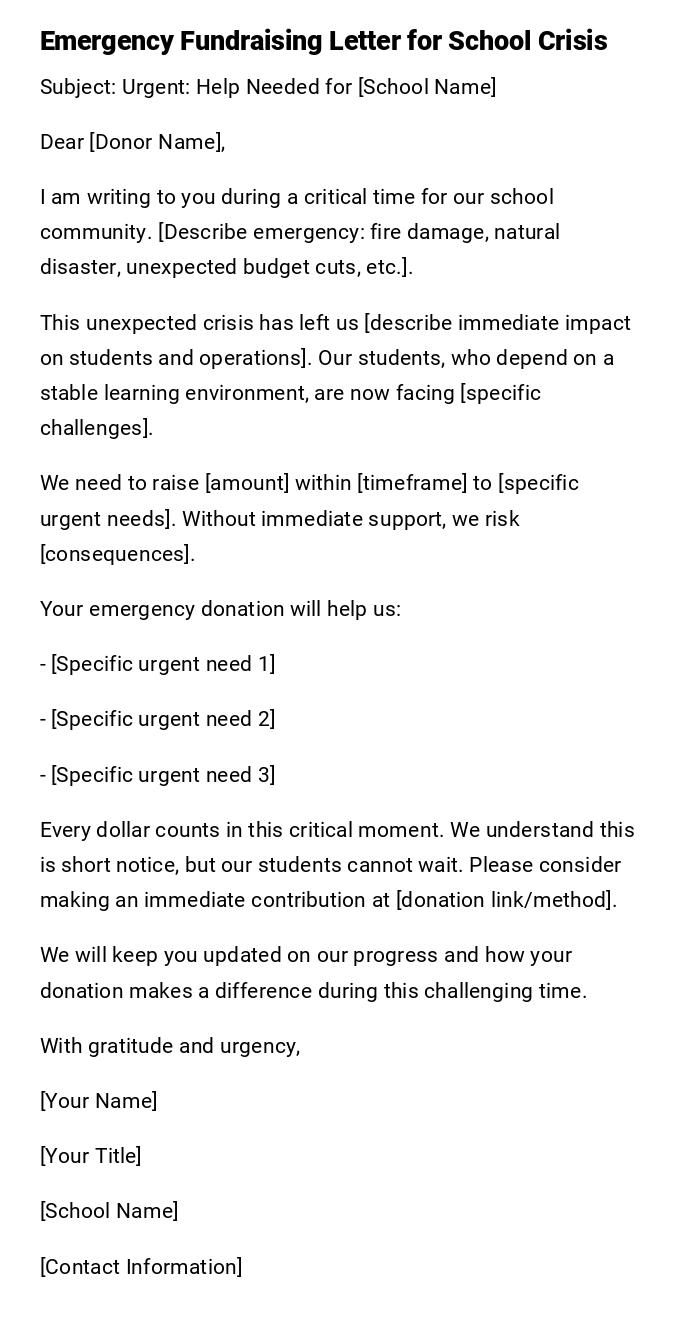
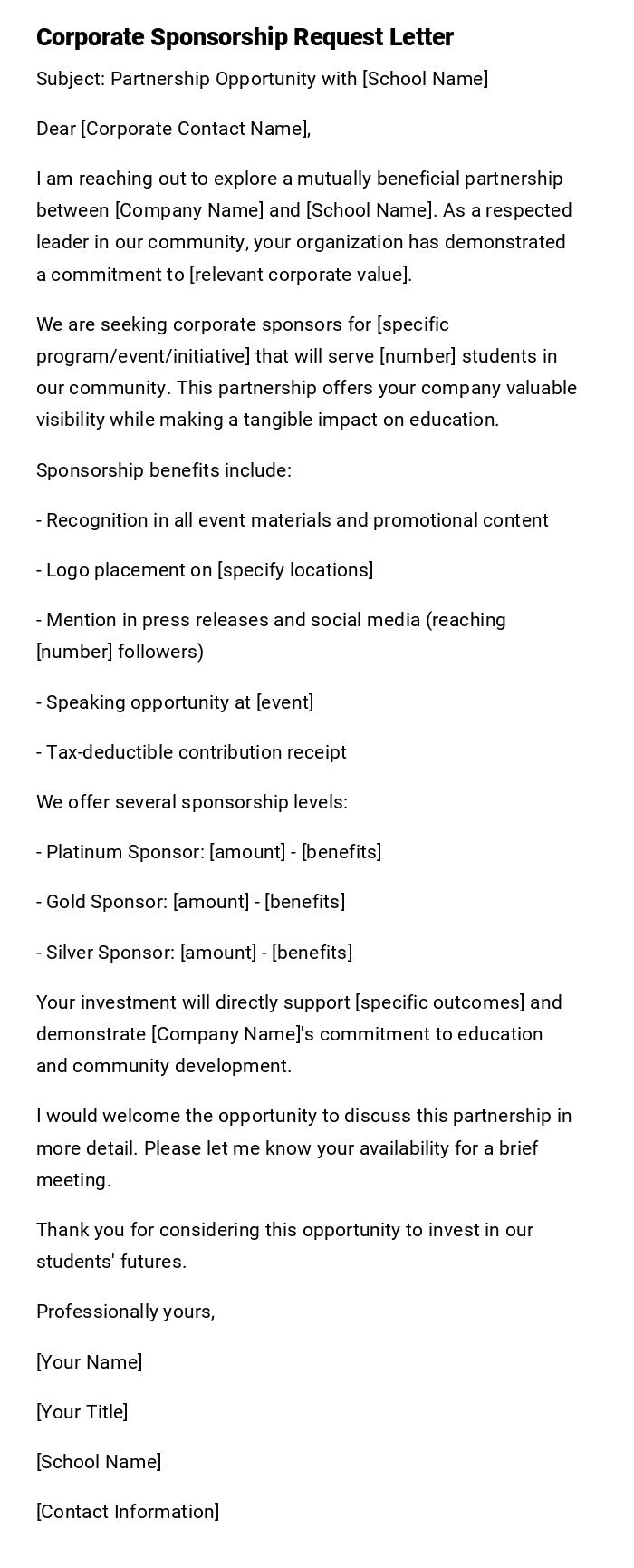
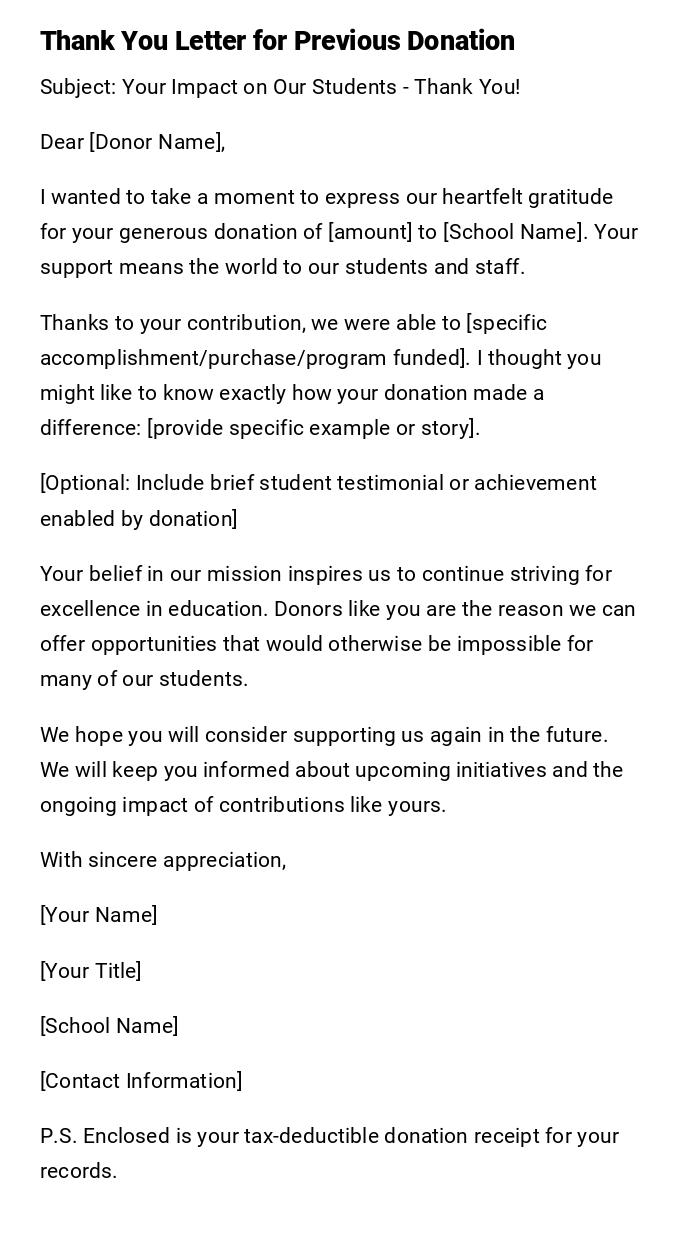
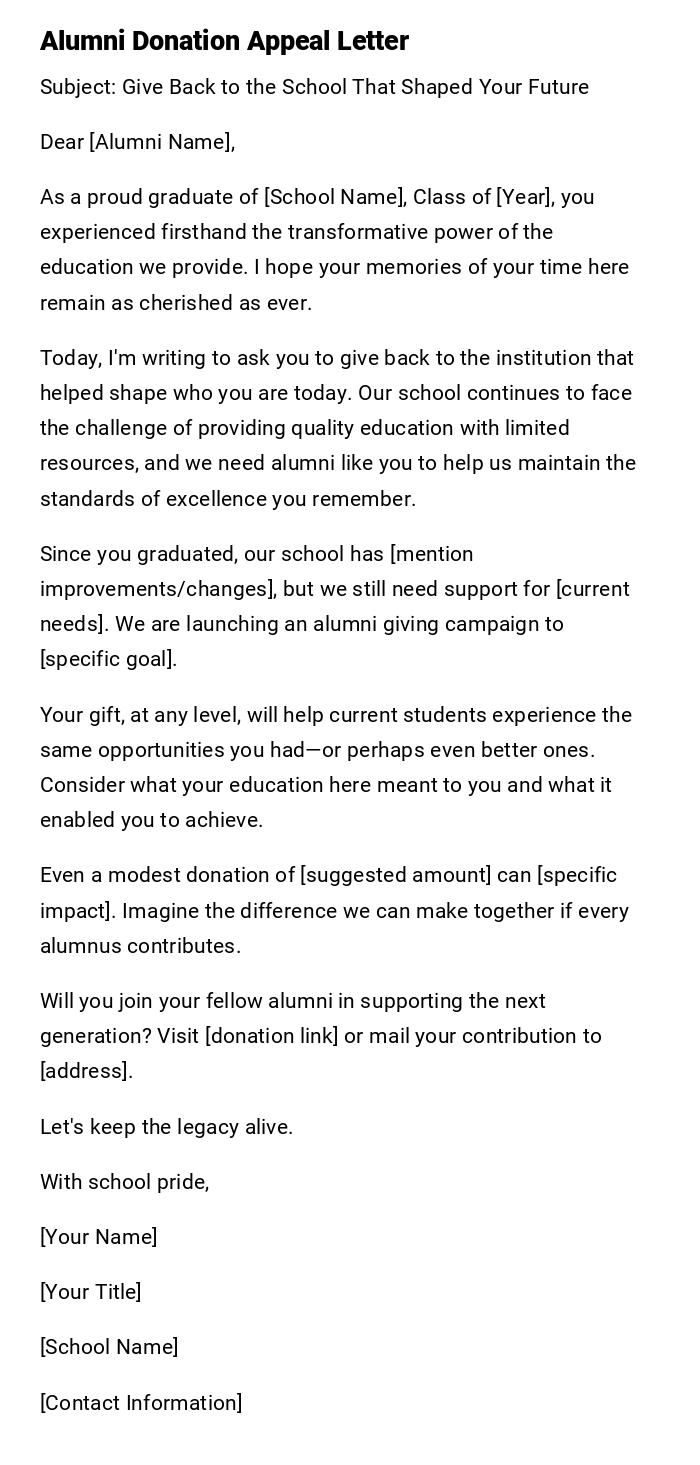

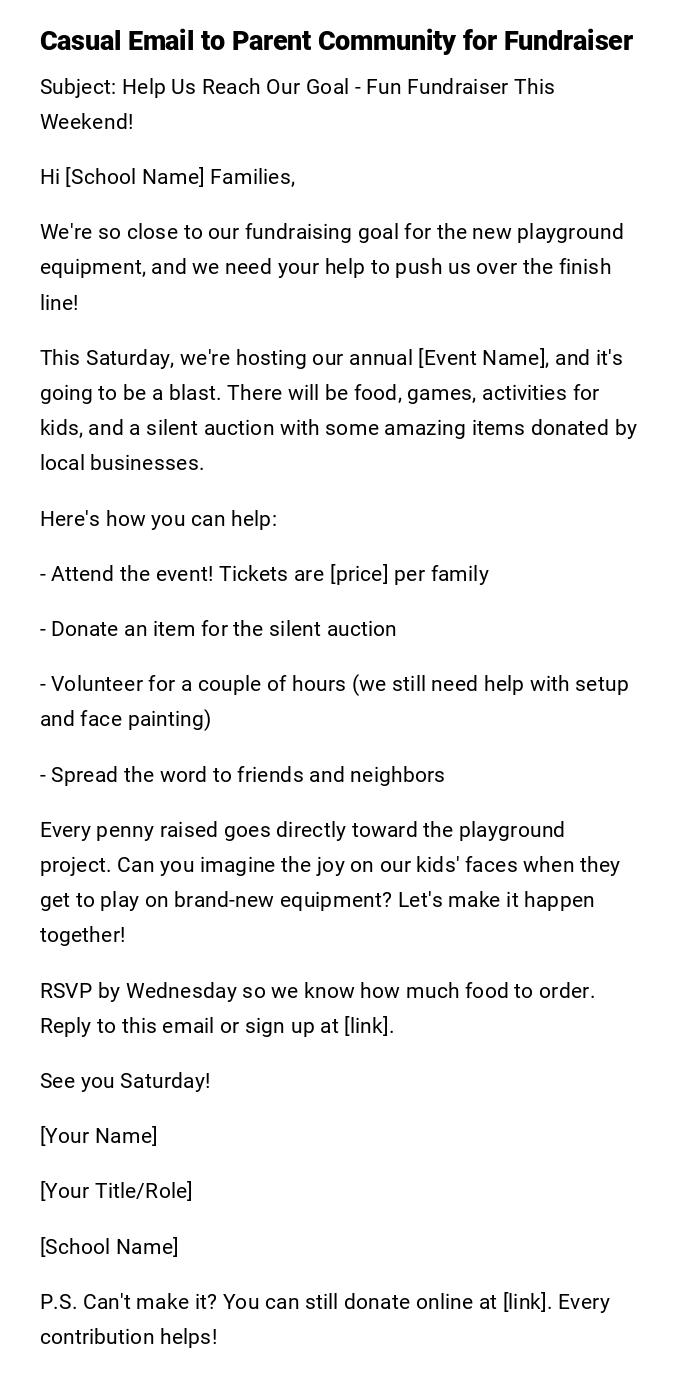
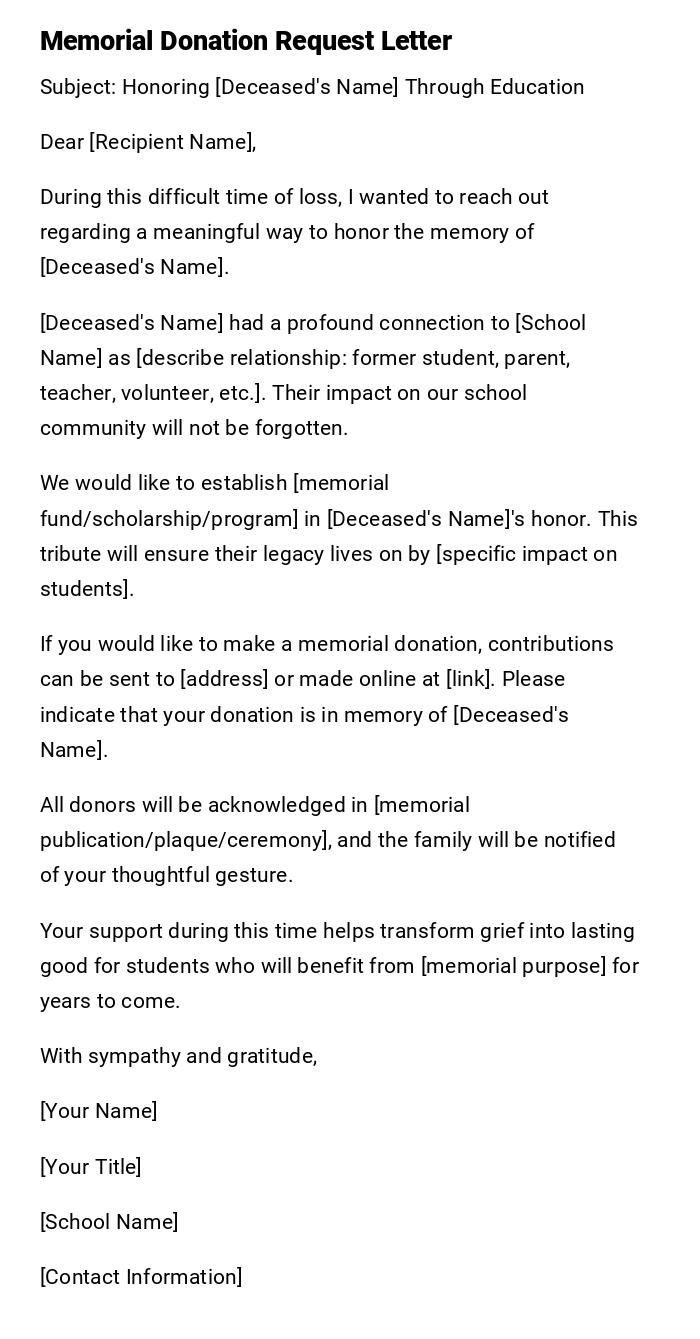

 Download Word Doc
Download Word Doc
 Download PDF
Download PDF